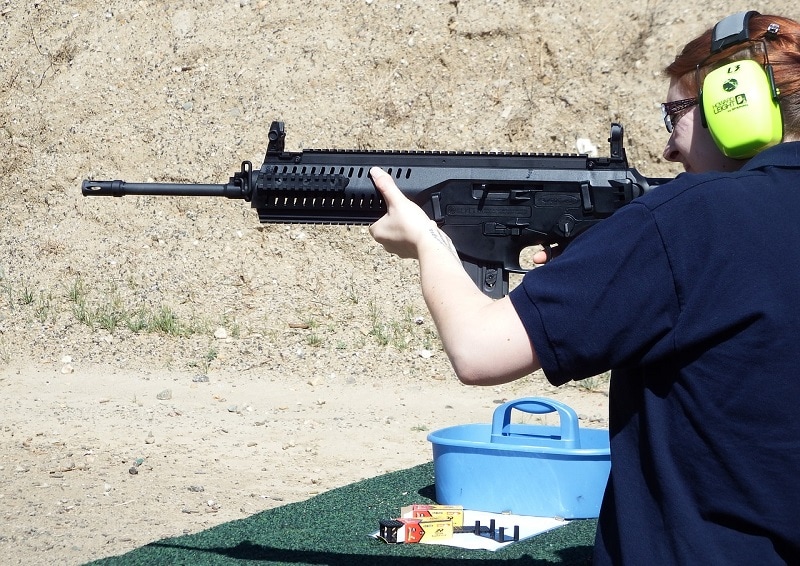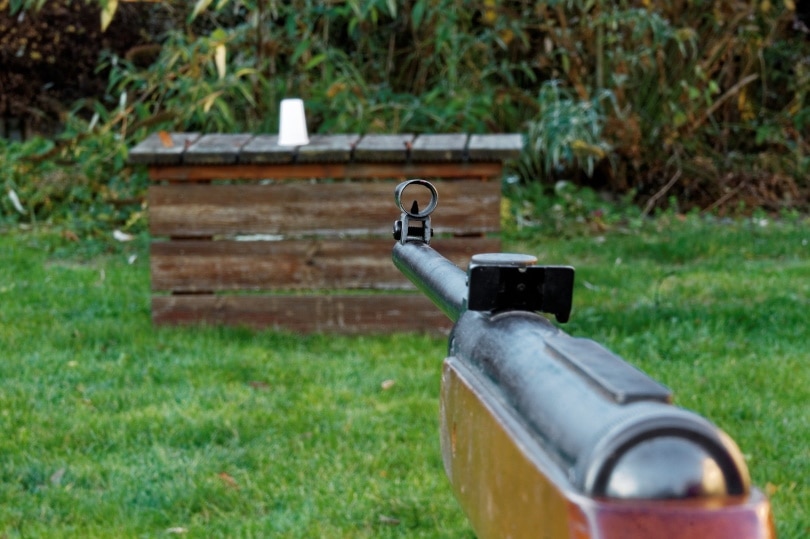How to Use & Aim With Iron Sights for AR-15
Last Updated on

Just about every AR-15 variant will ship with iron sights pre-mounted on the top of the rifle. For many shooters, especially first-time purchasers, they may not purchase an optic to go with their rifle immediately, and this can be a good call. It’s smart to practice the basics and push the limits of your iron sights so you know exactly what you need in a scope before you drop the money for one.
If you’re not lucky enough to have a mentor or friend who can walk you through shooting with iron sights, it may not be immediately obvious how they are supposed to work. After all, there’s a fair amount of geometry involved, but it’s simple to understand how to line up your sights and get good shot placement on your target. First things first, though, let’s start with the basics.

Understanding the Basics
Sight Alignment
Your basic goal is to connect four dots in a straight line: your eye, the rear sight, the front sight, and the target. If you only align your eye with the front sight and the target, you’ll be lined up in the left-right direction, but your shot may still hit high or low. Lining up your rear sight with your front sight is what lets you accurately predict how high or low your shot is going to hit.
Sight Picture
The term “sight picture” refers to what you see when you line up your sights. You should see the rear sight, the front sight, and the target all on top of each other. Because the rear sight, front sight, and target are all different distances from your eye, only the one you are focusing on will be sharply in focus, and the other two will be blurry.
For target shooting, it is generally accepted to focus on the front sight and let the rear sight and target be a bit blurry. This is the best way to get started and you can experiment shooting target-focused as you get more range time under your belt.
https://www.instagram.com/p/CI6w9xNAVKj/
Types of Iron Sights
The sight picture you have will depend greatly on the type of iron sights you have. Most front sights will be some sort of post with either a rounded top or straight top:
Some front sights will be hollow in the middle so you can see the target through the middle of them:
Rear sights come in two basic styles: notch or peep sights. A notch style will be in either a v-shape, u-shape, or perhaps the bottom half of a hollow square. A peep sight will have a hollow circle that you look through to see the front sight and the rest of the target. Factory irons are usually a notch, while aftermarket sights that you buy separately and mount on will usually be peep sights.
Aiming with Iron Sights
Aiming with the two different types of rear sights is essentially the same. With a notch style rear sight and a post on the front sight, you will typically line up the front and rear sights so that they are the same height (see the graphic above), and so that the front sight is centered in between the two sides of the rear sight. Some sights will have markings to help this process go faster.
With a peep sight, you instead try to center the front sight in the middle of the peep sight. This may not be as easy as using a notch sight since it can be hard to tell whether the front sight is exactly centered.
If you’re worried about that but like the idea of a peep sight, you can find peep sights that are diamond-shaped rather than circular, which give you more clear lines that you can use to get a better estimate of when your front sight is centered in the rear sight.
When aiming, you should line your rear and front sights up with your eye first, then find your target, at least when you’re getting started. Handgun shooting or certain scenarios with your AR-15 may require you to line up the front sight with the target first, then adjust the rear sight, but while learning on a rifle it may be best to start with the front and rear sights, then adjust everything together to line up the target.
https://www.instagram.com/p/CI6w9xNAVKj/
Sighting In Your Irons
You may think that the iron sights that came with your rifle are already accurate because they’re physically mounted to the rifle so how off could they possibly be? They probably aren’t very far off, but they may need a little bit of adjusting once you have them in your hands. If this is the case, it’s most likely that you’ll need to move the rear sight in either the left or right direction.
You can sight in your irons at whatever distance you want, but it’s good to start at 50 yards and go from there. To sight it in, you simply shoot a grouping of at least three rounds, then adjust the rear sight in the direction it needs to go in order for your grouping to be hitting the center of the target. Sighting in irons isn’t complicated, and the manual that came with your rifle or sights should have instructions.
Other Shooting Fundamentals
Lining up your sight picture is all well and good, but there are a lot of other things that can throw off your shot and prevent you from getting a good placement. Here are a few of the fundamentals to keep in mind.
Breath Control
When you’re holding your arms out in front of you, you’d be surprised how much your breathing affects their movement. While you’re learning, it’s good to get in the habit of always shooting at the same point during your breathing process, usually right as you finish letting out a breath.
If you want to be prepared for a self-defense scenario, you’ll want to practice staying perfectly on target while you breathe so you can be prepared to pull the trigger at any point. You can learn to compensate for your breathing by paying close attention and practicing.
There are a lot of other things that can cause your body to move; your arms may begin to get tired, your feet may not be planted properly (if you’re standing), it may be windy, etc. Pay attention to how these things are affecting your shots and learn to adjust accordingly.

Trigger Squeeze
The phrase “pull the trigger” is a bit of a misnomer. Pulling on the trigger is possibly the best possible way to throw off your shot. You’ll want to squeeze the trigger instead. Squeeze slowly as you’re learning and pay attention to how the motion of squeezing the trigger affects where the rifle is pointing.
It’s common for instructors to tell students that they should squeeze so slowly they should be surprised when the gun fires. The more you shoot, the faster you’ll feel comfortable squeezing the trigger without it disrupting your shot placement.
Follow-Through
The biggest issue with follow-through when shooting a rifle is the anticipation of the recoil. Shooters, especially new shooters, tend to tense up as they squeeze (or pull) the trigger because they’re expecting that recoil to slam them in the shoulder. You should already have the rifle tucked tightly before you start squeezing the trigger and try not to anticipate the recoil.
So don’t tense up as you’re squeezing the trigger; tighten everything up before you start squeezing and hold it until after you’ve shot.

Conclusion
So, there are a few different types of iron sights, but generally, you want to align the rear sight, front sight, and target all in a row which creates your sight picture. You then control your breath, tighten the rifle into your shoulder, slowly squeeze the trigger, and there you go. Iron sights do take practice, and it can be nice to get a red dot or scope, both of which replace the front and rear sight with just a single aiming point.
Featured Image Credit: socaljournalist, Pixabay
About the Author Robert Sparks
Robert’s obsession with all things optical started early in life, when his optician father would bring home prototypes for Robert to play with. Nowadays, Robert is dedicated to helping others find the right optics for their needs. His hobbies include astronomy, astrophysics, and model building. Originally from Newark, NJ, he resides in Santa Fe, New Mexico, where the nighttime skies are filled with glittering stars.
Related Articles:
How to Collimate Binoculars: 9 Expert Tips
Binocular Magnification Chart: Numbers & Distances Compared
When Were Binoculars Invented? History, Today & Future
Monocular vs Telescope: Differences Explained (With Pictures)
Can You Use Binoculars to Look At Stars? How to Choose the Right Pair
How to Choose Binoculars for Bird Watching: 10 Expert Tips
How to Sight a Laser on a Pistol (8 Tips & Tricks)
What Game Can You Hunt in North Carolina? 25 Common Game
